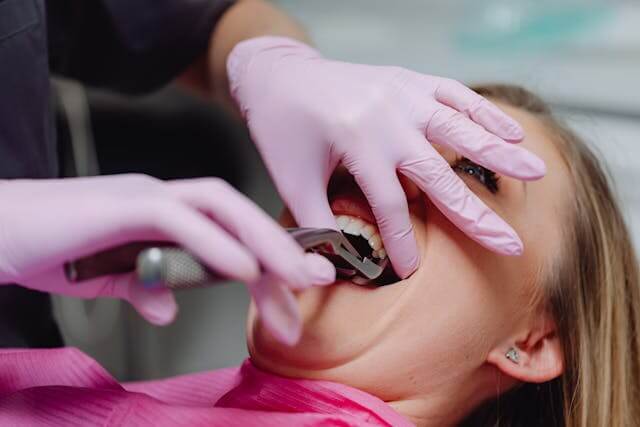3rd molar extraction is one of the common procedures in the dental facility. In fact, according to research, the lower third molars are the most commonly extracted teeth. People may develop a problem with their third molar if it has dental caries, submerged with the gum over it or when it is not properly formed.
This article will be focusing on the reasons why a 3rd molar extraction may be necessary, the different ways of third molar removal, and the complications that could follow after the extraction.
What Is a Third Molar?
Molars are posterior teeth. There are three of them on each side of both upper and lower jaws. They include first, second and third molars. The 3rd molar is the last tooth in the series. It is also the last to erupt. It usually comes out between the ages of 17-22 years.
The 3rd molar is also called a wisdom tooth. The removal of this tooth is what we call 3rd molar extraction.
Why Remove the 3rd Molar?
There are a number of reasons why a 3rd molar extraction may be indicated. Let’s take a look at some of them.
1. Infection
The third molar can develop tooth decay. If the decay is extensive and has entered the central part of the tooth called the pulp, there will be pain. In cases where root canal treatment is not feasible, removal of the tooth becomes an option .
Infection can arise if the gum behind the third molar is overgrowing it enabling food packing underneath the gum. This type of infection causes severe pain, swelling, and in some cases difficulty in opening the mouth. Dentists refer to it as pericoronitis. It is most common on the lower 3rd molars.
Pericoronitis has a tendency to reoccur after treatment that is why the definitive treatment is extraction of the impacted 3rd molar.
2. Periodontal Disease
The periodontium refers to the tooth supporting structures. An infection affecting any of these structures causes periodontal diseases. These diseases cause pain, pus, gum swelling and loosening of the teeth. Poor oral hygiene is usually the main cause and they can affect any tooth. If no treatment is given on time, the 3rd molar may become loose leading to its extraction.
3. Presence of Retained Roots
Retained roots refer to a situation where the crown of a tooth is absent leaving only the roots. The commonest cause of retained roots is tooth decay. When dental caries progresses without treatment, overtime, it will end up eating up the entire crown of the tooth. Other causes include incomplete tooth extraction and less commonly tooth fracture.
4. 3rd Molar Impaction
In some individuals, one or more wisdom teeth may be trapped in the bone either in part or as whole. When this happens, dentists call it third molar impaction. There are a couple of reasons why this may occur. A common reason is because there is not enough space for the wisdom tooth to erupt. This is common with the lower 3rd molars.
Impacted third molars may not cause issues. However, when it becomes symptomatic, the treatment is 3rd molar extraction.
5. Mandibular Fracture
Lower jaw fractures are common. They are the third most common facial fractures.
Breakage of the jaw bone may be due to accidental falls, contact sports, road traffic accidents. In our environment, bike accidents are one the commonest causes.
Lower jaw fracture can lead to fracture of a tooth or loosening of teeth. If the fracture line compromises the survival of a tooth, removal of that tooth will be the next option.
5. Overgrowth of a Third Molar
After removal of a wisdom tooth, the opposing third molar will likely grow into the space after some years. This is called supraeruption.
When this happens, it presents a couple of problems like pain, difficulty in chewing and injury to the gum by the opposing tooth.
Extraction is an option for a supra-erupting 3rd molar, especially when the individual has not extracted a number of other teeth.
Types of 3rd Molar Extraction
Basically, there are three main types of 3rd molar extraction. They include simple, intra-alveolar, and surgical extractions.
1. Simple Extraction
Simple forceps extraction involves the use of extraction forceps to to remove a tooth already indicated for removal. A tooth elevator is an instrument that loosens the tooth from its socket before pulling it out with an extraction forcep.
Simple Extraction can be done for a third molar if it is well erupted. Otherwise other methods of extraction may be considered.
2. Intra Alveolar Extraction
This method of tooth extraction is used to remove retained roots including that of a 3rd molar.
This involves widening the alveolar bone to loosen the roots before picking them out with a root forcep.
3. Surgical Extraction
Surgical extraction involves raising a flap to expose the alveolar bone, bone removal to expose the tooth and then loosening and removing the tooth.
This extraction method is used for the removal of impacted teeth, which is common with the 3rd molar.
Complications of 3rd Molar Extraction
3rd Molar extraction may come with some inconveniencing experiences. They include the following:
Pain
During dental extraction, the dentist will numb the tooth for removal with a local anaesthetic agent so that the patient does not feel pain during the procedure. After the procedure, the dentist or oral surgeon will place the individual on pain medication for about three days. However, some patients may still experience pain either because they didn’t take the analgesic early enough or due to other factors like inflammation.
Bleeding
The extraction site may start bleeding after tooth extraction. This usually occurs when the patient does not follow post operative instructions or when there is a background bleeding disorder.
If you experience bleeding from a 3rd molar extraction site, don’t panic. Get a sterile gauze or a piece of clean handkerchief. Fold it, place it on the socket and bite hard for about 5 minutes. If bleeding doesn’t stop, present to the nearest accident and emergency.
Swelling
This is likely to occur after surgical extraction or if the 3rd molar removal was traumatic. Your dentist will prescribe an antiinflammatory medication if he suspects you will likely have oedema after extracting your tooth.
Trismus
Trismus refers to muscle spasm in the temporomandibular joint resulting in limited mouth opening. It can also occur after surgical or traumatic removal of the lower third molar. Trismus resolves as the surgical site heals and by doing jaw exercise.
Infection
The extraction site may become infected if the patient has poor oral hygiene. Other causes may include poor adherence to post operative instructions, uncontrolled diabetes among other factors.
If there is infection of the extraction site, it is important you see a dentist as soon as possible to avoid spread of the infection to surrounding structures.
Dry Socket
Dry socket means the extraction socket is not covered with blood clot. The common symptom is usually severe pain coming from the empty extraction socket.
Dry socket tends to occur when the blood clot that forms on the extraction socket fails to form, forms insufficiently, or dislodges exposing the alveolar bone. It usually occurs within the first three days after tooth extraction.
Nerve Injury
This is a rare complication of lower jaw 3rd molar extraction. It involves injury to the inferior alveolar nerve that often passes in close proximity to the roots of the mandibular third molar. Inferior alveolar nerve agitation, injury, or on rare occasions, damage may occur during the extraction.
Injury to the inferior alveolar nerve will lead to abnormal sensation or numbness on the chin, teeth, and lower lip on the side of the affected jaw.
Conclusion
Third molar extraction is quite common. The extraction can present some complications too. That is why you have to visit a qualified dentist or oral surgeon for proper assessment and treatment if you are having a problem with your wisdom tooth.
Avoid delaying dental care as it can either worsen the situation or increase the chances of coming down with complications. Ensure you visit your physician for fitness assessment if you have an underlying condition like diabetes melitus and/or elevated blood pressure before undergoing tooth extraction.









